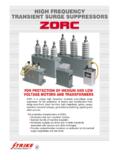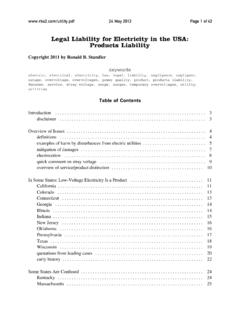Transcription of Design considerations for system-level ESD circuit protection
1 28 Analog Applications JournalTexas instruments IncorporatedHigh-Performance Analog Products 4Q 2012 Interface (Data Transmission) Design considerations for system -level ESD circuit protectionIntroductionAs technology has evolved, mobile electronic devices have also evolved to become an integral part of people s lives and cultures. The advent of haptics for tablets and smart-phones has encouraged increasing interaction with these devices. This creates the perfect environment for electro-static discharge (ESD) hazards, or the discharge of static electricity from a body surface to a device.
2 In the case of consumer electronics, for example, ESD can occur between a user s finger and a tablet s USB or HDMI connector and cause irreversible damage to the tablet, such as spiked standby current or permanent system article explains the difference between system -level and device-level ESD phenomena and offers system -level Design techniques that are targeted to protect against everyday ESD versus device-level ESD protectionESD damage to ICs can occur at any time, from assembly to board-level soldering to end-user interactions.
3 The incidence of ESD-related damage dates back to the dawn of semiconductors, but it didn t become a prevalent prob-lem until the 1970s with the introduction of the microchip and thin-gate-oxide FETs for highly integrated ICs. All ICs have built-in device-level ESD structures that protect the IC against ESD events during the manufacturing phase. These events are simulated by three different device-level models: the human-body model (HBM), the machine model (MM), and the charged-device model (CDM). The HBM is intended to emulate ESD events caused by human han-dling, the MM to emulate ESD events caused by automated handling, and the CDM to emulate ESD events caused by product charging/discharging.
4 These models are used for testing in the manufacturing environment, where assem-bly, final testing, and board-level soldering are performed in controlled ESD environments that limit the level of ESD stress to which the device is exposed. In the manufactur-ing environment, ICs are usually specified to survive ESD strikes only to a 2-kV HBM, while lower-geometry devices have recently been specified to as low as 500 device-level models are usually sufficient for the controlled ESD environment of the factory floor, they are completely inad equate for system -level testing.
5 The levels of ESD strikes from both voltages and currents can be much greater in the end-user environment. For this reason, the industry uses a different method for system -level ESD testing, defined by the IEC 61000-4-2 standard. Device-level HBM, MM, and CDM tests are intended to ensure only that ICs survive the manufacturing process; system -level tests specified by IEC 61000-4-2 are intended to simulate end-user ESD events in the real are two types of system -level tests specified by the IEC: contact discharge and air-gap discharge.
6 In the contact-discharge method, the test-simulator electrode is held in contact with the device under test (DUT). In air-gap discharge, the charged electrode of the simulator approaches the DUT, and a spark to the DUT actuates the range of test levels specified in the IEC 61000-4-2 standard for each method is given in Table 1. It is impor-tant to note that the severity of each test level is not equivalent between the two methods. Stress levels are usually incrementally tested above level 4 (the highest official level for each method) until the point of Roger LiangSystems EngineerTable 1.
7 Test levels for contact-discharge and air-gap- discharge methodsCONTACT-DISCHARGELEVELTEST VOLTAGE ( kV)AIR-GAP-DISCHARGELEVELTEST VOLTAGE( kV)12122424363848415 texas instruments Incorporated29 Analog Applications Journal4Q 2012 High-Performance Analog ProductsInterface (Data Transmission)Table 2. Comparison of device-level models and IEC system -level modelHUMAN-BODY MODEL (HBM)MACHINE MODEL (MM)CHARGED-DEVICE MODEL (CDM)IEC 61000-4-2 MODELD efinitionHuman body discharging accumulated staticRobotic arm discharging accumulated staticCharged device being groundedReal-world ESD eventsTest levels (V)500 to 2000100 to 200250 to 20002000 to 15000 Pulse Width (ns)~150~80~1~150 Peak Current at Applied 2 kV (APK)1.
8 33 ~57 .5 Rise Time25 ns < 400 ps< 1 nsNumber of Voltage Strikes22220 Device-level models and system -level models have some distinct differences, as highlighted in Table 2. The last three parameters in Table 2 current, rise time, and number of voltage strikes are of par-ticular concern: The difference in current is critical to whether the ESD-sensitive device survives an ESD strike. Because high current levels can cause junction damage and gate-oxide damage, it is possible that a chip protected by an 8-kV HBM (with a peak current of A) can be destroyed by a strike to a 2-kV IEC model (with a peak current of A).
9 Thus, it is extremely important that system designers do not confuse HBM ratings with ratings for the IEC model. Another difference lies within the rise time of the voltage strikes. The rise time specified for an HBM is 25 ns. The pulse of the IEC model has a rise time of less than 1 ns and dissipates most of its energy in the first 30 ns. If an HBM-rated device takes 25 ns to respond, the device can be destroyed before its protection circuits are even activated. The number of strikes used during testing is different between the models.
10 The HBM requires only a single positive and single negative strike to be tested, whereas the IEC model requires ten positive strikes and ten negative strikes. It is possible for a device to survive the first strike but fail on subsequent strikes due to damage sustained during the initial strike. Figure 1 shows example ESD waveforms for a CDM, an HBM, and the IEC model. It is apparent that the IEC model s pulse carries much more energy than the pulse of each device-level a TVS protects a system against ESD eventsInstead of integrated structures for ESD protection , the model specified by the IEC 61000-4-2 standard usually uses discrete stand-alone transient-voltage-suppressant diodes, or transient-voltage suppressors (TVSs).

















